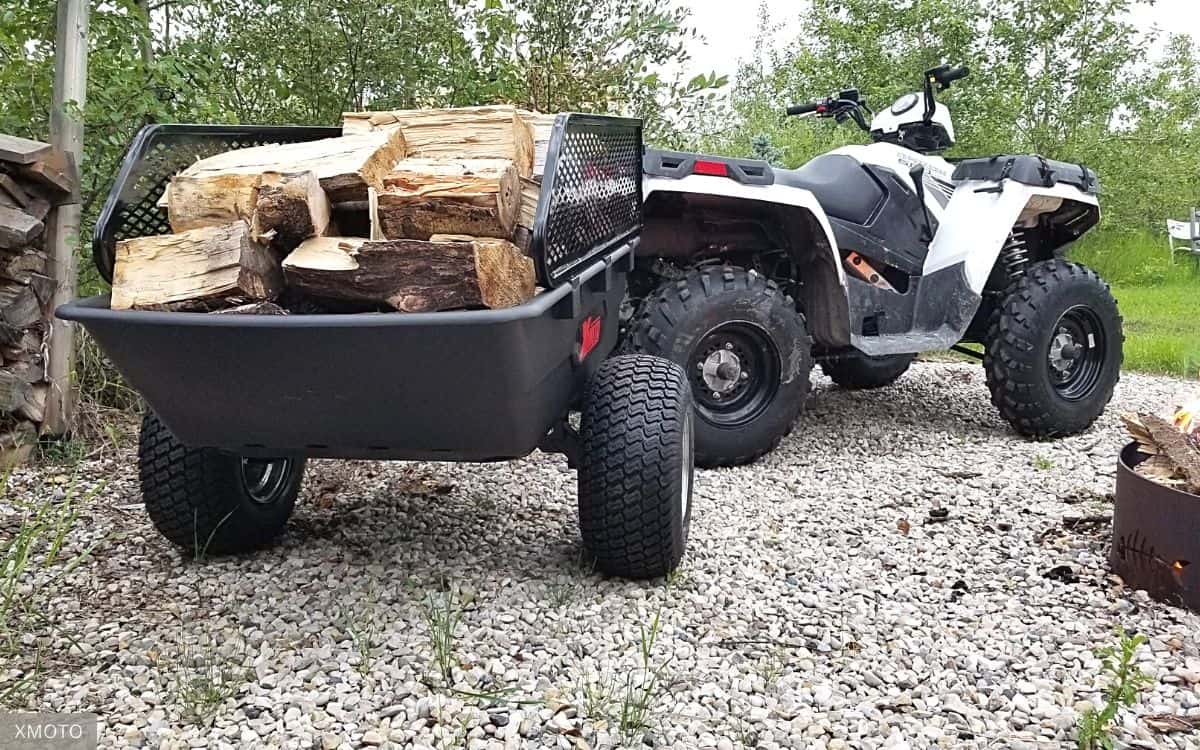Thanks to the ATV’s versatile design, they are great for both recreation and utility tasks.
But can ATVs pull a trailer?
The short answer is yes – most ATVs can pull a small trailer.
However, if you plan to tow an ATV trailer, you need to keep reading, as this question is not so cut and dry in practical terms.
As ATVs come in various types and sizes, with a wide range of engine displacements that can impact the machine’s horsepower and towing capacity.
So to provide a more definitive answer to this question, we’ve created this comprehensive blog post, covering everything you need to know about safely pulling a trailer with an ATV.
Including factors to consider, optimal use cases for hauling, and guidelines for safely towing an ATV trailer.
Plus, we’ll also answer some common questions about ATV towing.
Key Factors To Consider When Towing a Trailer with an ATV
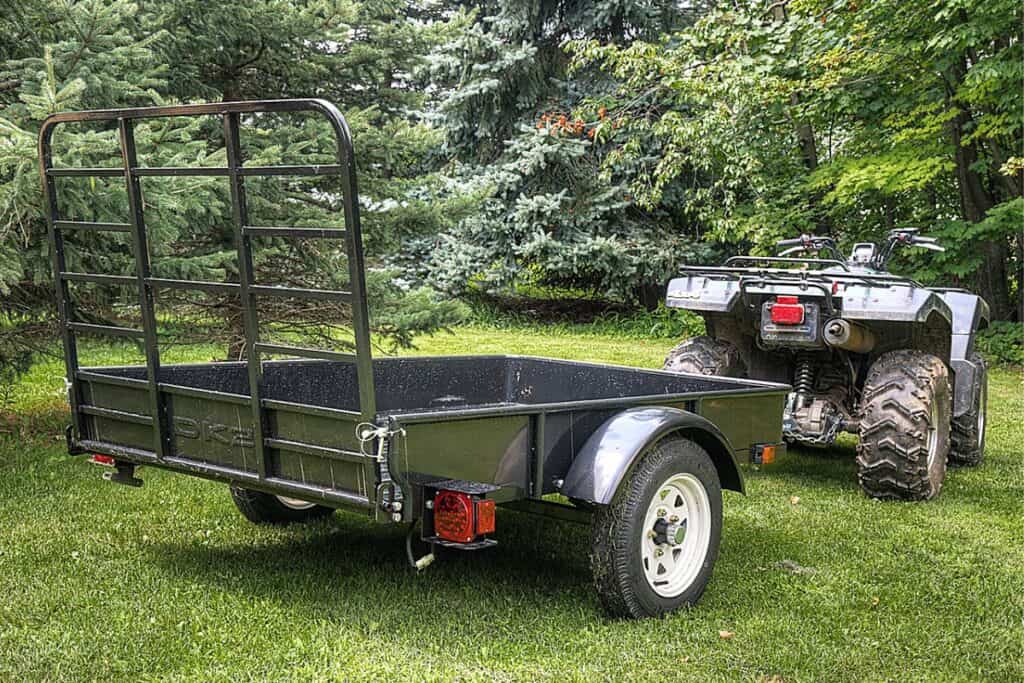
Determining if your ATV model can safely pull a trailer depends on several important factors.
So you should never just hitch up any trailer to your quad without checking these specifics first:
Does Your ATV Model Support Towing?
The most fundamental question is verifying if your particular ATV make and model was designed for towing by the manufacturer.
To figure this out, you should check the following:
- The owner’s manual for the maximum tow rating and tongue/hitch weight supported.
- Performance aspects such as engine size, drivetrain, and chassis.
Always confirm your four-wheeler’s capability and towing capacity to avoid component failure or loss of control.
In general, though, most ATVs can usually tow between 500 to 1,800 pounds, depending on the make and model.
What Type & Size of Trailer Do You Need?
It’s important to carefully match the trailer to your needs and machine’s abilities.
The best way to do this is to:
- Decide what type of ATV trailer best fits your needs; some popular choices include, utility trailers, dump trailers, off-road trailers, and flatbed trailers.
- Figure out the trailer’s empty and fully loaded weight, and ensure both numbers are below the ATV’s max tow capacity.
- Match the hitch type and tongue weight against what the ATV hitch can accommodate.
- Consider the number of axles, as more axles help to distribute weight better for heavier loads.
- Keep the trailer’s dimensions close to the size of the ATV to improve stability and handling while hauling.
What Type of Tow Hitch Does Your ATV Have?
You can’t just hitch up any old trailer without the proper equipment installed first.
So it’s important to account for:
- Whether the ATV already has a suitable hitch mount or if it needs one installed.
- The size of the hitch mount and ball on the ATV and how that matches up to the trailer’s tongue receiver.
- Location of the hitch mount.
Always use the correct hitch specified by the manufacturer.
Attempting to tow excessive loads with inadequate hitch equipment can cause safety issues and damage the ATV and the trailer.
Best Use Cases For Pulling an ATV Trailer
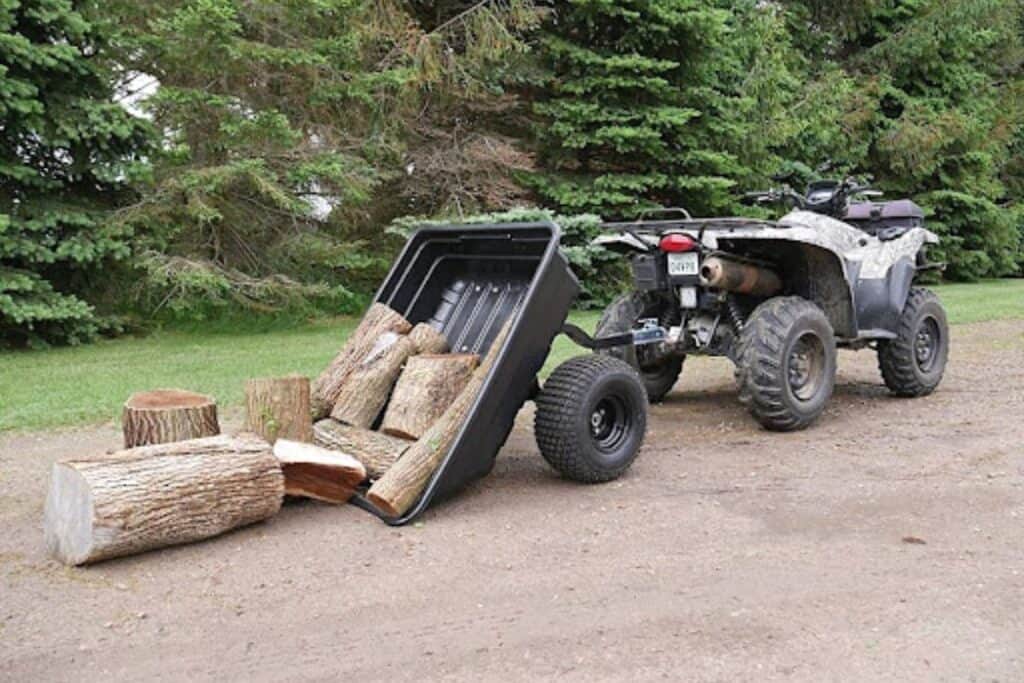
ATVs are already incredibly useful for a variety of tasks and jobs all on their own.
However, when you equip an ATV with a small trailer, its utility increases significantly, as this setup allows for more efficient transportation of materials, tools, or even recreational gear.
Enhancing the ATV’s versatility in both work and leisure.
Our Favorite Use Cases
Below we’ve listed some of our favorite use cases for hooking a trailer to an ATV.
- Transport Gear for Adventure Trips – A trailer lets you hitch up your camping gear, gas cans, tools, and other equipment to trek deep into the backcountry. Bring everything needed for a multi-day camping excursion without overloading the quad.
- Haul Tools and Building Supplies Around Your Property – Maintaining acreage means constantly moving equipment from one project to the next. An ATV trailer eliminates multiple equipment trips, allowing you to bring everything you need in one trip.
- Makes Chores Easier – A little trailer makes quick work of tasks that require carrying loads like yard debris, firewood, or trash. Hitch it behind the ATV to accomplish small-scale towing jobs faster.
- Assist with Large-scale Gardening and Farming – An ATV can be a handy tool for gardeners and farmers when equipped with a trailer. Perfect for transporting seed, fertilizer, harvests, or even small livestock across farmlands or orchards.
- Support Hunting and Fishing Expeditions – For the avid hunter or angler, a trailer attached to an ATV can carry hunting blinds, decoys, fishing gear, coolers, and the day’s catch or game, making the journey to and from remote spots much more manageable.
- Facilitate Outdoor Event Preparation – Whether setting up for a wedding, family reunion, or other outdoor events, ATVs with trailers can haul chairs, tables, decorations, and supplies to the site, easing the burden of manual transport.
- Expand Winter Maintenance Capabilities – During winter, a trailer can help transport salt, sand, snow blowers, or shovels, making snow and ice removal tasks with an ATV across a large property more efficient.
How to Safely Operate an ATV with a Trailer
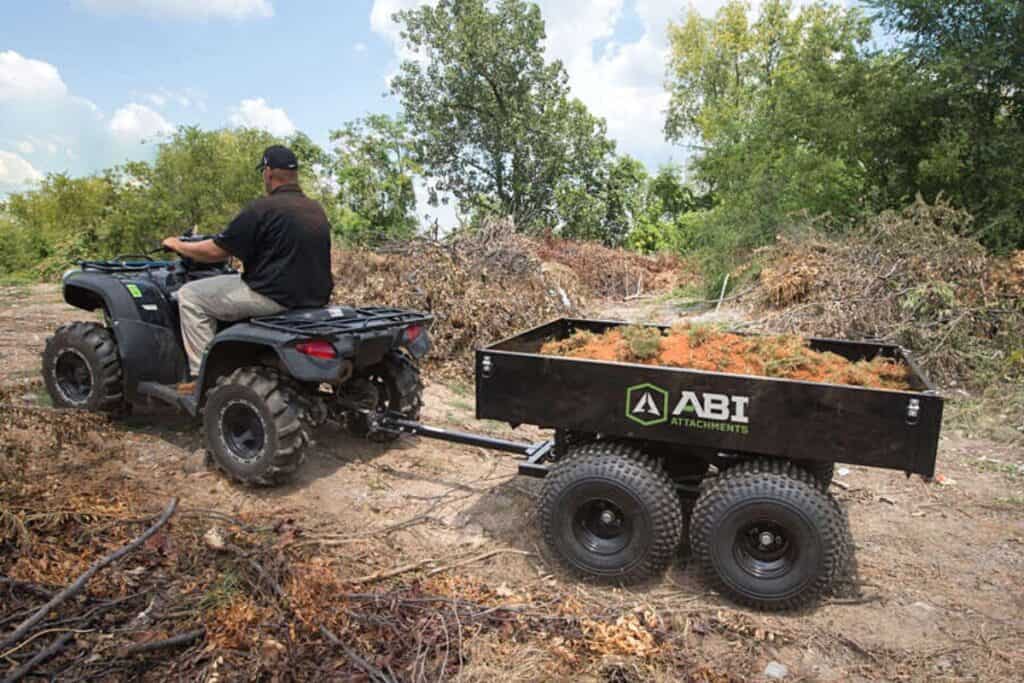
Once you’ve confirmed your ATV’s tow rating, equipped it with the proper hitch mounts, and attached an appropriately sized trailer, operating the ATV/trailer combo safely is the final piece of the puzzle.
And the best way to do this is to follow the below best practices.
Master Driving Technique, Handling, & Speed
Attaching a trailer to an ATV greatly impacts the driving metrics and handling of the four-wheeler.
So as a beginner, it’s important to spend some time getting used to operating the ATV with a trailer attached, by traveling at lower speeds and practicing maneuvering the ATV/trailer combo in an open area without obstacles.
This will help you develop a feel for the extended braking distances, wider turns, and the overall dynamics of towing.
Only after gaining confidence in these basic handling aspects should you progress to more complex environments or load the trailer with cargo.
Allow Extra Distance & Time to Stop
The increased weight of an attached trailer, especially one fully loaded, greatly impacts braking and the distance required to bring the ATV to a full stop.
Because of this, when hauling with a quad, you should always leave at least 3 times the following distance and begin braking much earlier.
This allows you to apply the brakes gradually with consistent pressure for a more controlled deceleration when stopping an ATV under load.
Practice Proper Load Distribution
Understanding and implementing proper load distribution is crucial when towing with an ATV.
Ensure that the weight in the trailer is spread evenly, with slightly more weight placed toward the front of the trailer, close to where it attaches to the ATV. This helps maintain stability and prevents the trailer from swaying or fishtailing.
An unevenly loaded trailer can cause handling problems, making the ATV more difficult to control, especially at higher speeds or on uneven terrain.
It’s also vital to secure the load firmly in place to prevent shifting during transit, which can alter the weight distribution dynamically and lead to dangerous situations.
Also, don’t forget to periodically check the load during longer trips to ensure that nothing has moved or come loose.
Check & Maintain Proper Air Pressure
It’s also important to make sure that the ATV and trailer tire pressures stay at manufacturer-recommended levels, especially when the trailer is under load.
Proper tire inflation is key to maintaining traction, ensuring even wear, and preventing blowouts.
Under-inflated tires can overheat, particularly under heavy loads, while over-inflated tires may lead to a rough ride and decreased stability.
Because of this, it’s always a good idea to check tire pressure and adjust it according to the weight of the load and the manufacturer’s specifications to ensure a safe and efficient towing experience.
It’s also a good idea to periodically inspect tires thoroughly for signs of wear and age deterioration, to keep your setup in proper working order and to prevent being stranded by a flat.
Remain Highly Alert On Inclines & Turns
While you should always be alert operating an ATV, especially on inclines, declines, and turns, it’s even more important while towing with an ATV.
This is because the shifted center of gravity and pivot point between the ATV and trailer greatly increases the risk of roll-overs and or jackknives when climbing or descending hills and while cornering.
So while traversing these terrains or cornering, you should always be especially cautious, reduce your speed, and steer gently while maintaining momentum, for safe operation under tow.
Are ATVs Good for Towing?
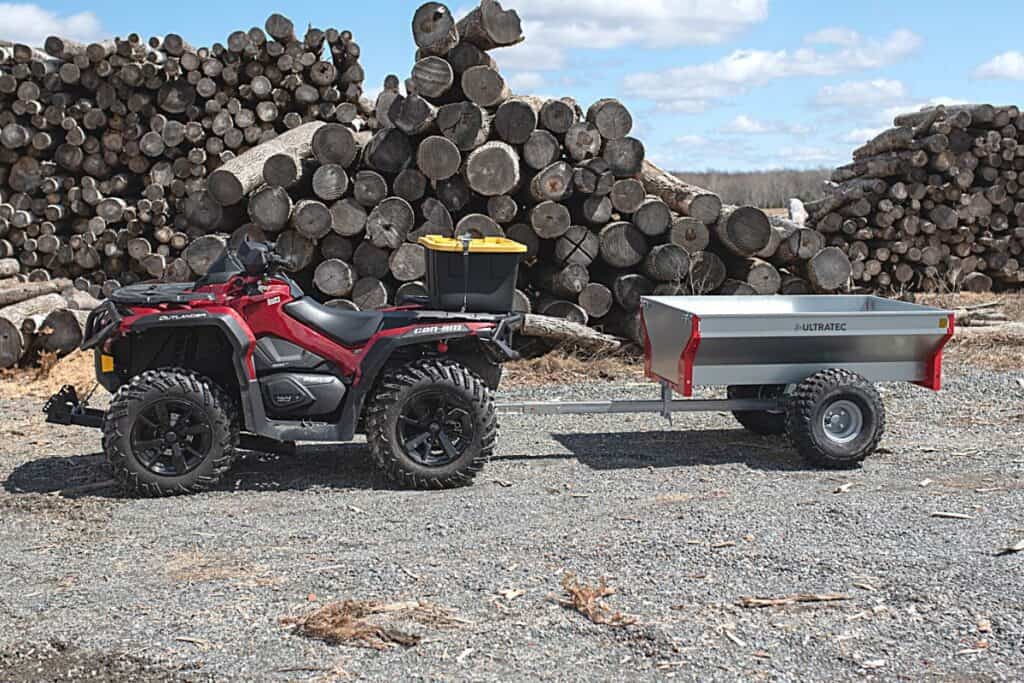
ATVs make great tow vehicles, especially off-road, as long as you stay within their towing capabilities.
They are designed to handle a variety of terrains which makes them particularly useful for towing in off-road or rugged conditions where traditional vehicles might struggle.
However, there can be a big difference in towing capability from one ATV to the next.
For example, a small 300cc sport model will be able to pull far less compared to a large 1000cc utility model.
Utility ATVs are typically engineered with towing in mind, featuring robust frames, and powerful engines, and often come with standard towing hitches and other accessories designed for hauling and towing.
When considering an ATV for towing, it’s important to assess the type of work you intend to do.
For light garden work or small game hunting, a mid-range 500cc ATV might suffice.
However, for more demanding jobs, like moving heavy equipment or large amounts of agricultural produce, a high-displacement 750cc ATV would be more appropriate.
Always refer to the owner’s manual for specific towing capacities and recommended practices.
It’s also wise to invest in good quality towing equipment, such as robust hitches and sturdy trailers from trusted brands like ABI Attachments and Polar.
How Do You Hook Up a Trailer to a Four-Wheeler?
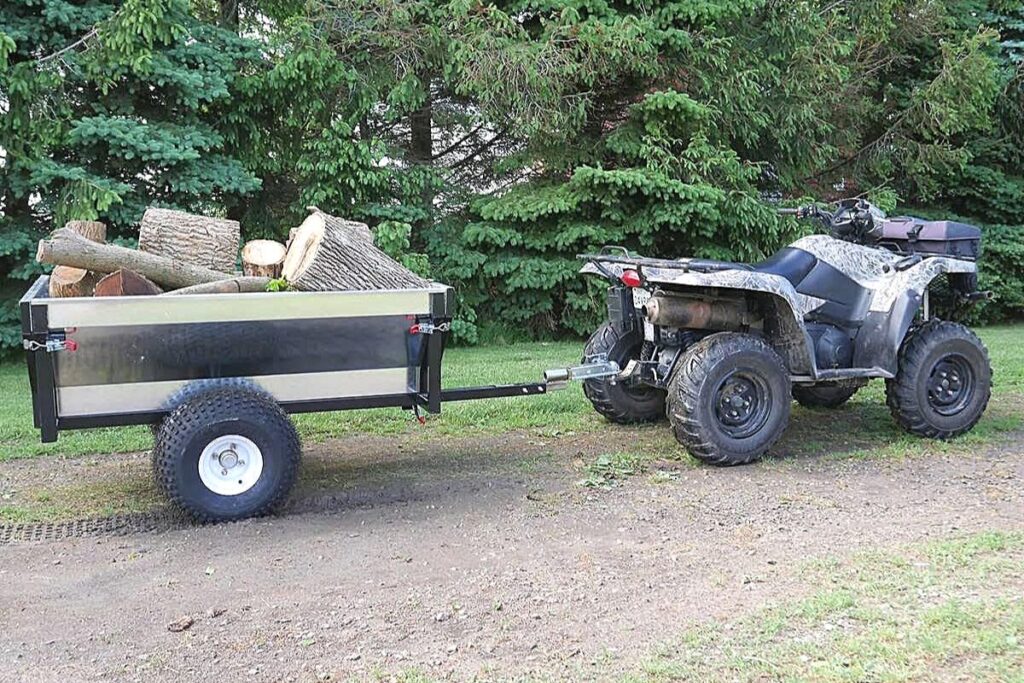
The process of attaching a trailer to a four-wheeler is not overly complicated, however, several steps need to be followed to properly attach one.
So we created the below step-by-step process to ensure that you always have a solid connection between your four-wheeler and trailer.
Step-By-Step Process
- Position the ATV and Trailer: Begin by aligning your ATV with the trailer. The ATV should be on a flat, stable surface, and positioned so that the hitch on the ATV aligns with the trailer’s coupler.
- Inspect the Hitch and Coupler: Before attaching, inspect the ATV’s hitch and the trailer’s coupler for any damage or excessive wear. Also, ensure they are compatible in size and type.
- Lower the Coupler onto the Hitch: If the trailer has a jack, use it to lower the coupler directly onto the ATV’s hitch ball until it’s fully seated. For trailers without a jack, you may need to manually lift and lower the trailer tongue onto the hitch ball.
- Secure the Coupler: Lock the coupler onto the hitch ball by closing the latch. Insert a hitch pin or a coupler lock to ensure the coupler does not come loose while towing.
- Check the Tires: Ensure that both the ATV and the trailer tires are inflated to the manufacturer’s recommended pressure.
- Load the Trailer: Load your cargo evenly, with a larger portion of the weight positioned in front of the trailer’s axle and centered from side to side. Secure the load with straps or nets to prevent shifting.
- Perform a Safety Check: Double-check that the coupler, pins, and clips are properly connected and installed. Inspect the cargo to make sure it is secure.
- Test Before Use: Once everything is attached, drive the ATV a short distance in an open area to test the trailer’s connection. Make any necessary adjustments before heading out.
Recent Posts
Is Can-Am Better Than Polaris? This question has been debated for years, sparking intense debates in off-road communities and showrooms. As two titans in the world of ATVs and UTVs, Can-Am and...
Whether you're an adult looking for a new adventure or introducing your kids to the sport, finding the best beginner dirt bike is crucial to kick-start your off-road journey on the right...

